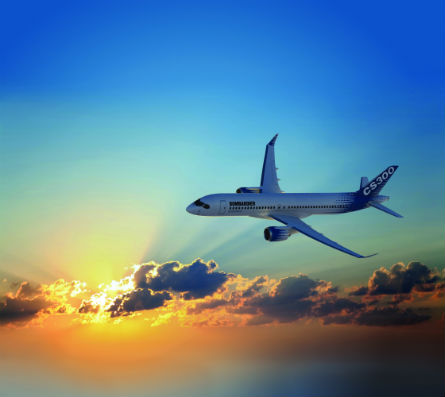Bombardier will soon begin constructing a CSeries final assembly centre designed to build 100 of the type annually from a single production line, initially with seven positions on a partially pulsed line. Final assembly of the first complete static-test airframe is scheduled to be finished in September, followed immediately by assembly of the first flight test airframe FTV-1.
The next four test aircraft will be produced at one-month intervals, with the first production airframe scheduled for delivery about 12 months after FTV-1 completes its maiden flight. Production will ramp up quickly after entry into service of the 110-seat CS100, with all 138 CSeries jets on order delivered less than three years later. As new orders stretch the CSeries backlog, Bombardier plans to continue increasing the production ramp, first to 100 aircraft a year, then 200 - on a second production line if necessary.
To realise such an ambitious strategy, a new Bombardier leadership team is challenging itself - and a supply chain with major component assemblies spread across five countries - to behave in a radically different manner.
Gary Scott, who launched the CSeries programme in 2008, stepped down last October. He was succeeded as president of Bombardier's commercial aircraft unit in January by Mike Arcamone, a Montreal native and career automotive executive who has swiftly put his mark on production operations.
 |
|---|
Bombardier Bombardier aims to begin deliveries a year after the maiden flight |
BUREAUCRACY
"I don't like charts. I don't like PowerPoints. I detest bureaucracy," he says. "We've made certain changes. I like to be very visible. I like to communicate, so everyone in commercial aircraft knows what I am doing every couple of weeks, for example."
If Arcamone does not appreciate paper briefings, he is enamoured with simulation - digital and hands-on. In the CSeries programme, he found much of what he liked already. Inside the complete integrated aircraft systems test area, Bombardier has begun advanced simulations of the CS100's electronics, hydraulics and software. Arcamone extended the ground-based simulations, ordering assembly workers to build a full-scale wooden replica of the CS100 inside the Y hangar of Bombardier's factory in Mirabel, Quebec. This tool, including a wooden mock-up of the CSeries auxiliary power unit, is a simulated work environment.
"We don't wait for all of our parts to arrive in Mirabel. We actually have built a wooden [aircraft]. We've simulated the design [of the production system]. We don't wait until the parts arrive and then we train our people. We have actually installed production tools in Mirabel," Arcamone says.
Those simulations have prompted Bombardier to tweak the production system, says Francois Minville, vice-president of CSeries manufacturing. Original plans envisaged fuselage assembly and wing-join at one station, but Bombardier has split the two operations. "When we did the simulation actually moving those components around, and the people moving around it, we realised it was not feasible," Minville says. "We could not achieve the rate we wanted."
PHILOSOPHY
A different philosophy also prevails for Bombardier's suppliers, which includes Alenia Aermacchi building empennage components, Bombardier units building the wing in Ireland and fuselage components in Quebec, Pratt & Whitney building the engine in Quebec and Shenyang Aircraft building the centre fuselage in China. "The old days, saying: 'I'm going to send you the part, you test it.' And then we find out, when we put it together: 'Surprise! It's not me, it's the other supplier.' We're trying to change that as well," Arcamone says.
Changes have not visibly affected the production system as Bombardier has compressed a five-month assembly process for FTV-1 to four months.
Source: Flight International



















